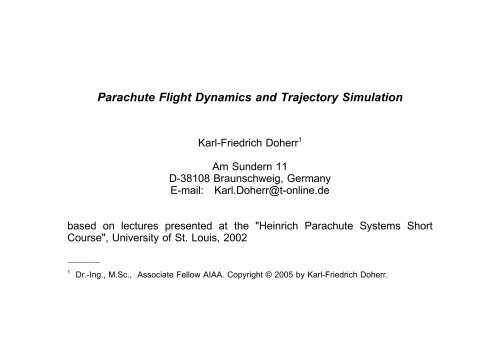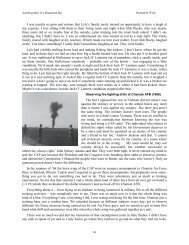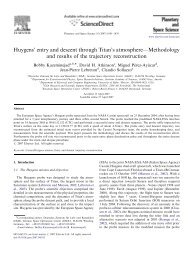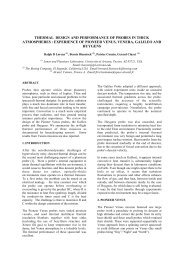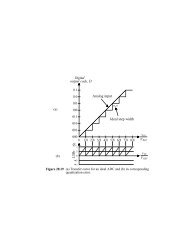10 Parachute Flight Dynamics and Trajectory Simulation Doher
10 Parachute Flight Dynamics and Trajectory Simulation Doher
10 Parachute Flight Dynamics and Trajectory Simulation Doher
Create successful ePaper yourself
Turn your PDF publications into a flip-book with our unique Google optimized e-Paper software.
<strong>Parachute</strong> <strong>Flight</strong> <strong>Dynamics</strong> <strong>and</strong> <strong>Trajectory</strong> <strong>Simulation</strong><br />
Karl-Friedrich <strong>Doher</strong>r 1<br />
Am Sundern 11<br />
D-38<strong>10</strong>8 Braunschweig, Germany<br />
E-mail: Karl.<strong>Doher</strong>r@t-online.de<br />
based on lectures presented at the "Heinrich <strong>Parachute</strong> Systems Short<br />
Course", University of St. Louis, 2002<br />
__________<br />
1 Dr.-Ing., M.Sc., Associate Fellow AIAA. Copyright © 2005 by Karl-Friedrich <strong>Doher</strong>r.
- Knacke, T.W., "<strong>Parachute</strong> Recovery Systems Design Manual", NWC TP<br />
6575, Para Publishing, Santa Barbara, CA, 1992.<br />
Remark: Figs. 5-46 <strong>and</strong> 5-50 have been used in the following lecture.<br />
- Cockrell, D.J., "The Aerodynamics of <strong>Parachute</strong>s", AGARDograph No.<br />
295, 1987.<br />
- Wolf, D.F., "The Dynamic Stability of a Non-Rigid-<strong>Parachute</strong> <strong>and</strong> Payload<br />
System", J. Aircraft, Vol. 8, No. 8, August 1971, pp 603-609.<br />
- <strong>Doher</strong>r, K.-F. ; Schilling, H., "Nine-Degree-of-Freedom <strong>Simulation</strong> of<br />
Rotating <strong>Parachute</strong> Systems", J. Aircraft, Vol. 29, No. 5, Sept.-Oct. 1992.<br />
- <strong>Doher</strong>r, K.-F., "Extended <strong>Parachute</strong> Opening Shock Estimation Method",<br />
AIAA 2003-2173, 17th Aerodynamic Decelerator Systems Technology<br />
Conference <strong>and</strong> Seminar, 19-22 May 2003, Monterey, California.<br />
Some Literature
Questions:<br />
- <strong>Trajectory</strong><br />
Where is the parachute-payload system at what time?<br />
- Force history<br />
What are the peak forces?<br />
- Dynamic Stability<br />
Does the system oscillate?
My Strategy:<br />
Offering you a Bundle of Illusions by:<br />
- Setting up Mathematical Models<br />
- Presenting some Closed-form Solutions<br />
- Applying Computer Codes
Why Illusions?<br />
1. <strong>Parachute</strong>s are Stochastic Systems<br />
with large scatter of their performance characteristics<br />
2. The atmosphere is of stochastic character<br />
(gusts, wind-shear, up- <strong>and</strong> down-winds in the order<br />
of the parachute velocity of descent)<br />
3. There are almost never enough experiments<br />
to validate the mathematical models<br />
(due to lack of time, money, test equipment, staff etc.)<br />
4. <strong>Parachute</strong>s are literaly too cheap<br />
to attract big research money <strong>and</strong> public interest
So, what will you get today?<br />
Some tools to study the effect of<br />
selected parachute parameters
Example:<br />
Cylindrical Payload (L) released from climbing aircraft at<br />
h A = <strong>10</strong>0 m, V A = 150 m/s<br />
A = + <strong>10</strong>°, A = + 5°, A = +15°<br />
shall be decelerated by a parachute<br />
<strong>and</strong> l<strong>and</strong> at steady state velocity V e = 27.3 m/s<br />
Find / calculate:<br />
1. suitable parachute<br />
2. time it takes to achieve steady state velocity<br />
3. snatch force<br />
4. opening shock (max inflation force)<br />
5. angle of attack oscillations, horizontal <strong>and</strong> vertical<br />
6. trajectory<br />
Study Case
Study Case : Example
- Rigid body mathematical models get<br />
already very complex with 9 DoF =<br />
6 DoF of payload +<br />
3 DoF of parachute rotating<br />
relative to payload<br />
<strong>Parachute</strong> - Payload System<br />
- We will consider simplified systems<br />
with 2 DoF <strong>and</strong> 3 DoF<br />
- Most important design parameter:<br />
Drag area C DS:
<strong>Trajectory</strong> analysis Point Mass Planar<br />
Rigid<br />
Body<br />
6DOF<br />
Rigid<br />
Body<br />
9DOF<br />
2 Rigid<br />
Bodies<br />
Degrees of freedom DOF 2 3 6 9<br />
Major Variables x, z x, z, x, y, z,<br />
, ,<br />
Decelerator<br />
Input<br />
Coupling Conditions<br />
Mass<br />
Inertias<br />
C DS (drag area)<br />
C N (normal)<br />
C l (roll)<br />
X CP (center of pressure)<br />
ij (apparent masses)<br />
x, y, z,<br />
, , ,<br />
P, P, P
System <strong>Flight</strong> Stages<br />
I Payload free flight<br />
C DS = const<br />
II <strong>Parachute</strong> deployment to<br />
fully-stretched rigging;<br />
snatch force F S<br />
III Inflation:<br />
C DS = f(t)<br />
opening shock F x<br />
IV Deceleration <strong>and</strong><br />
Stabilization<br />
C DS -> const<br />
oscillation?<br />
V System Descent<br />
C DS = const
Stage Analytical Solutions Computer Programs<br />
I<br />
Free <strong>Flight</strong><br />
II<br />
Deployment<br />
III<br />
Inflation<br />
IV<br />
Deceler <strong>and</strong><br />
Stabilization<br />
Point mass 2 DoF<br />
C DS = const<br />
- horizontal / vertical flight<br />
Two point masses, each 1 DoF<br />
--> Snatch force F s<br />
C DS = f(t)<br />
Pflanz' approximation<br />
--> Opening shock F X = F(t) max<br />
C DS = const<br />
= (t); 3 DoF<br />
2DOFT05<br />
SNATCH<br />
Fx05<br />
2DOFT05<br />
OSCILALH<br />
OSCILALV<br />
V Descent C DS = const 2DOFT05<br />
Plan of Attack
I Payload Free <strong>Flight</strong><br />
V System Steady Descent<br />
with constant drag area C DS
Equations of motion in earth fixed coordinates (2DOFT05)<br />
Non-linear differential equations:<br />
Initial conditions:
Non-linear algebraic relations:<br />
flight path angle<br />
drag<br />
drag area<br />
density<br />
atmosphere wind, thermal upwind, gusts
Simplified cases:<br />
C DS = const., = const, V W = 0<br />
(no parachute; or parachute undeployed; or parachute fully open;<br />
small changes in altitude; no wind):<br />
horizontal flight: vertical flight:
Vertical flight:<br />
System decelerates (or accelerates) until drag becomes equal weight:<br />
V ---> V e<br />
equilibrium for t<br />
steady state velocity =<br />
velocity of descent<br />
System parameters (m, , C D, S, g) can be replaced by<br />
one parameter V e only!
horizontal flight vertical flight<br />
where: ˆV V/V e ; ˆt t g/V e ; ˆx xg g/V 2<br />
e ; ˆz zg g/V 2<br />
e<br />
a ( ˆV A 1) / ( ˆV A 1)
V / VA<br />
1<br />
0.8<br />
0.6<br />
0.4<br />
0.2<br />
FIG2_2 | 27.4.1997<br />
Velocity decay in horizontal flight<br />
range of practical interest<br />
flight path angle < 15 deg<br />
V A / V e = 1.0<br />
5.0<br />
<strong>10</strong>.0<br />
20.0<br />
0<br />
0 0.2 0.4 0.6 0.8 1<br />
t * g / Ve
xg * g / Ve 2<br />
2<br />
1.5<br />
1<br />
0.5<br />
FIG2_3 | 26.4.1997<br />
Distance travelled in horizontal flight<br />
V A / V e = 1.0<br />
5.0<br />
<strong>10</strong>.0<br />
range of practical interest<br />
0<br />
0 0.2 0.4 0.6 0.8 1<br />
t * g / Ve
V / Ve<br />
5<br />
4<br />
3<br />
2<br />
1<br />
FIG2_4 | 26.4.1997<br />
Velocity decay in vertical flight<br />
V A / V e = <strong>10</strong>.0<br />
5.0<br />
2.0<br />
1.0<br />
0.5<br />
0<br />
0 0.2 0.4 0.6 0.8 1<br />
t * g / Ve
h * g / Ve 2<br />
0<br />
-1<br />
-2<br />
-3<br />
-4<br />
VA VA / Ve Ve = 0.5<br />
1.0<br />
2.0<br />
5.0<br />
<strong>10</strong>.0<br />
20.0<br />
Altitude change in vertical flight<br />
-5<br />
0 0.5 1 1.5 2<br />
t * g / Ve FIG2_6 | 26.4.1997
Task #1: Find suitable parachute<br />
- select parachute: non-oscillating parachute, i.e. Guide Surface<br />
- determine parachute diameter:<br />
Drag = (C DS) e<br />
2<br />
/2 Ve = m g drag = weight in steady descent<br />
(C DS) e = 40*9.81 / (0.5*1.224*27.3 2 ) = 0.860 m 2<br />
required drag area<br />
C D = C Dc = 0.65 drag coefficient, from parachute h<strong>and</strong>book<br />
S c = 0.86 / 0.65 = 1.324 m 2<br />
required parachute constructed area<br />
D c = (4 * 1.324 / ) 0.5 = 1.3 m required parachute constructed diameter<br />
l s = 1.2 * D c = 1.65 m selected length of suspension lines<br />
Study Case: <strong>Parachute</strong> Selection
Task #2: Determine time until steady state<br />
Rough estimate:<br />
It takes about 1 step of non-dimensional time to delerate the system (with<br />
non-reefed, fully open parachute).<br />
t * g/V e<br />
1<br />
t V e / g = 27.3 / 9.81 2.8 s<br />
Comparison with 2-DoF simulation<br />
(including free-flight phase without parachute):<br />
t 3 s<br />
Study Case: Deceleration Time
II <strong>Parachute</strong> Deployment<br />
with constant drag areas (C DS) L <strong>and</strong> (C DS) P<br />
Snatch Force F s
FIG4-1 | 30.4.1997<br />
V s<br />
F s<br />
V L<br />
l s<br />
Snatch Force<br />
m L<br />
V s<br />
F s<br />
V P<br />
l s<br />
V A<br />
m P<br />
t A<br />
t i<br />
t s
Snatch Force Estimation (SNATCH)<br />
conservation of energy<br />
conservation of momentum<br />
kinetic energy that gets stored
where V A initial velocity at begin of deployment, <strong>and</strong><br />
velocity difference at snatch<br />
distance<br />
distance at snatch
With<br />
potential energy stored<br />
in suspension lines<br />
Hooke's law<br />
spring constant
snatch force for<br />
F s nk s s 2 n k E linear elongation<br />
For general material properties of the type:<br />
r = 1 -> linear material properties (Hooke'sches Law)<br />
r =/ 1 -> nonlinear material properties<br />
F s<br />
n F B1<br />
(r 1) E<br />
B l s n F B1<br />
r<br />
r 1<br />
Snatch Force
Measured T-<strong>10</strong> Snatch Forces (from P. Schuett, DLR-Mitt. 69-11, p. 95)
Task #3 : Estimate Snatch Force (use SNATCH)<br />
1 INPUT File SNATCH.DAT for SNATCH98.EXE<br />
2 for snatch force estimation<br />
3 University of Minnesota <strong>Parachute</strong> Technology Short Course<br />
4 _____________<br />
1.224 RO : air density kg/m^3<br />
39.25 ML : mass of the load kg<br />
0.0314 CDSL : drag area of the load m^2<br />
0.75 MP : mass of the parachute pack kg<br />
0.0314 CDSP : drag area of the pilot chute m^2<br />
150.0 V0 : initial speed of both masses m/s<br />
1.64 LS : length of suspension line m<br />
8 N : number of suspension lines -<br />
0.30 EPSB : relative elongation at break -<br />
6675 FB : break strength of susp. line N<br />
1 R : exponent of strain curve -<br />
0.0 TA : initial value of t2 s<br />
0.01 DT : step size of time s<br />
Study Case: Snatch Force
Results of SNATCH:<br />
Snatch occurs at t2 = 8.394841E-02 sec dels = 1.639999 m<br />
snatch force Fs = <strong>10</strong>081.66 N<br />
velocity at snatch Vs = 148.412 m/s<br />
difference velocity delV = 35.67168 m/s<br />
mass of the load mL = 39.25 kg<br />
CDS of the load CDSL = .0314 m*m<br />
mass of the parachute mP = .75 kg<br />
CDS of the parachute CDSP = .0314 m*m<br />
initial velocity V0 = 150 m/s<br />
suspension line length ls = 1.64 m<br />
number of susp. lines n = 8 -<br />
relative break length epsB = .3 -<br />
break strength of 1 line FB = 6675 N<br />
exponent of strain curve r = 1 -<br />
achieved load factor Fs/n*FB = .1887952 -<br />
Study Case: Snatch Force
III <strong>Parachute</strong> Inflation<br />
with drasticaly changing drag area C DS(t)<br />
Opening Shock F X
<strong>Parachute</strong> inflation force:<br />
or, non-dimensional,<br />
where V s = velocity at snatch <strong>and</strong> (C DS) e = steady state drag area.<br />
<strong>Parachute</strong> Opening Shock (max. Inflation Force)
We are looking for the maximum of x(t), called opening force factor C K,<br />
Knowing C K, the opening shock (filling shock) follows from<br />
<strong>Parachute</strong> Opening Shock (max. Inflation Force)
Pflanz- Ludtke Method:<br />
Pflanz' (1942):<br />
- introduced analytical functions for the drag area<br />
- integrated the equation of motion in horizontal flight ( = 0°)<br />
- calculated v(t) <strong>and</strong> x(t).<br />
- found closed form expression for C K<br />
Ludtke (1973): published method in a modified form in English<br />
<strong>Doher</strong>r (2003): extended method for arbitrary flight path angle .<br />
<strong>Parachute</strong> Opening Shock (max. Inflation Force)
Assume polynomial change of the drag area with time:<br />
tf j<br />
non-dimensional drag area<br />
inflation time,<br />
time when the drag area reaches (CDS) e the first time<br />
exponent<br />
Cx opening force coefficient (over-inflation factor)<br />
<strong>Parachute</strong> Opening Shock (max. Inflation Force)
1.6<br />
1.4<br />
1.2<br />
1<br />
0.8<br />
0.6<br />
0.4<br />
0.2<br />
0<br />
0 0.5 1 1.5<br />
NONPAPER | 6.3.2003<br />
v/v s<br />
C K<br />
Non-dimensional inflation variables<br />
x<br />
t /t f<br />
= (t/tf) 2 = (t/tf) 2<br />
t max/t f<br />
C x<br />
<strong>Parachute</strong> Opening Shock
Introduce ballistic parameters A <strong>and</strong> B:<br />
D 0<br />
F rs <strong>and</strong> F re<br />
n f<br />
V e<br />
parachute nominal diameter D0, Froude numbers at snatch <strong>and</strong> at steady state,<br />
non-dimensional inflation time<br />
steady state velocity of descent v e, defined by<br />
<strong>Parachute</strong> Opening Shock (max. Inflation Force)
In horizontal flight ( = 0°) <strong>and</strong> for sufficiently large V s/V e,<br />
If:<br />
then<br />
else<br />
<strong>Parachute</strong> Opening Shock (max. Inflation Force)
If =/ 0, or if V s/V e is small, then<br />
where<br />
<strong>Parachute</strong> Opening Shock (max. Inflation Force)
Opening Force Factor C K vs. Mass Ratio of reefed <strong>Parachute</strong>s<br />
(from Knacke, NWC TP 6575, p5-57)
Task # 4: Estimate opening shock (use Fx05)<br />
1 INPUT File Fx05.DAT of Fx05.EXE<br />
2 for opening shock estimation<br />
3 Pflanz method, see AIAA paper 2003-2173<br />
4 _____________<br />
1.224 RO : air density kg/m^3<br />
9.81 g : gravity constant m/s^2<br />
1.373 D0 : parachute nominal diameter m<br />
40.0 M : system mass kg<br />
0.86 CDSe : steady state system drag area m^2<br />
<strong>10</strong>.9 nf : non-dimensional inflation time -<br />
6 j : polynomial exponent -<br />
1.7 Cx : opening force coefficient -<br />
149.3 Vs : snatch velocity m/s<br />
<strong>10</strong> gammas : initial flight path angle deg<br />
Study Case: Opening Shock
Results:<br />
Opening shock Fx = 17973.39 N<br />
Load factor nx = 45.80374 -<br />
ballistic parameter A = 5.078238 -<br />
ballistic parameter B = 151.8693 -<br />
Opening force factor CK = 1.531595 -<br />
Uncorr opening force factor C0 = 1.535377 -<br />
Corr. factor for small Vs/Ve C1 = 0 -<br />
Corr. factor for gammas 0 C2 = -3.781822E-03 -<br />
air density RO = 1.224 kg/m^3<br />
gravity constant g = 9.81 m/s^2<br />
parachute nominal diameter D0 = 1.373 m<br />
system mass m = 40 kg<br />
steady state system drag area CDSe = .86 m^2<br />
steady state velocity Ve = 27.30484 m/s<br />
non-dimensnl inflation time nf = <strong>10</strong>.9 -<br />
polynomial coefficient j = 6 -<br />
opening force coefficient Cx = 1.7 -<br />
velocity at snatch Vs = 149.32 m/s<br />
flight path angle at snatch gammas = <strong>10</strong> deg<br />
Study Case: Opening Shock
IV System Deceleration <strong>and</strong> Stabilisation<br />
with constant drag area C DS<br />
Velocity decreasing<br />
Oscillation building up
Stability analysis of 3DoF-System (OSCILALx) with variables s, , <strong>and</strong><br />
Introduction of the parachute by the drag force D P only
3DoF-equations of motion in trajectory coordinates:
Stability analysis<br />
Case: Horizontal flight:<br />
A = 0; = const; gravity negelected: g = 0<br />
The linearized equations of motions have two eigenmodes:<br />
1. Exponential decay of the velocity along the flight path s<br />
2. Angle of Attack Oscillation
Damping <strong>and</strong> frequency:<br />
Conditions for dynamic stability:<br />
< 0 amplitude decreases (stabil)<br />
= 0 amplitude remains constant (neutral stability)<br />
> 0 amplitude increases (instable)<br />
<strong>Parachute</strong> reduces damping because of + (C DS) P/S L - term<br />
<strong>Parachute</strong> increases oscillation frequency
Task #5a: Estimate Dynamic Stability in Horizontal <strong>Flight</strong><br />
(Use OSCILALH.BAS)<br />
170 DATA 0.351 : READ TA: REM initial time<br />
180 DATA 122.5 : READ VA: REM initial velocity<br />
190 DATA 0.200 : READ DL: REM reference diameter of the load<br />
200 DATA 40.00 : READ M: REM mass of the load<br />
2<strong>10</strong> DATA 2.1 : READ IY: REM moment of inertia about y-axis<br />
220 DATA 0.400 : READ XH: REM attachment point of parachute<br />
230 DATA -1.00 : READ CXL0: REM CX of load at alfa = 0<br />
240 DATA -2.78 : READ CZLALF: REM dCZL/dalfa of load<br />
250 DATA 1.11 : READ CMLALF: REM dCML/dalfa of load<br />
260 DATA -<strong>10</strong>.0 : READ CMLQ: REM pitch damping deriv. of load; q*D/2V<br />
270 DATA 0.0 : READ CMPQ: REM pitch damping derivative of parachute<br />
280 DATA 0.65 : READ CDP0: REM drag coeff. of chute at alfa = 0<br />
290 DATA 0.96 : READ CDSP: REM drag area of chute<br />
Study Case: Dynamic Stability
Results of OSCILALH.BAS in horizontal flight<br />
Initial velocity VA = 122.5 m/s<br />
load diameter DL = .2 m<br />
system mass M = 40 kg<br />
moment of inertia Iy = 2.1 kg*m*m<br />
chute attachment point XH = .4 m<br />
load aerodynamics: CXL0 = -1 -<br />
CZLALF = -2.78 -<br />
CMLALF = 1.11 -<br />
CMLQ = -<strong>10</strong> -<br />
parachute data:<br />
drag coefficient CDP0 = .65 -<br />
drag area CDSP = .96 -<br />
pitch damping coeff. CMPQ = 0 -<br />
diameter DP = 1.371305 m<br />
angle of attack oscillation:<br />
CDSP DELTA [1/m] OMEGA*i [1/m]<br />
.96 6.24099E-03 .3314168<br />
VA [m/s] Ve [m/s] l[m]<br />
122.5 25.43085 18.95856<br />
Study Case: Dynamic Stability
[deg]<br />
[deg]<br />
V [m/s]<br />
FIG5_2 | 24.3.2004<br />
<strong>10</strong><br />
5<br />
0<br />
-5<br />
-<strong>10</strong><br />
<strong>10</strong><br />
5<br />
0<br />
-5<br />
-<strong>10</strong><br />
150<br />
<strong>10</strong>0<br />
50<br />
0<br />
Angle of attack in horizontal flight<br />
l = const<br />
0 20 40 60 80 <strong>10</strong>0<br />
s [m]<br />
T not const<br />
0.5 1 1.5 2<br />
time [s]<br />
0.5 1 1.5 2<br />
time [s]<br />
Study Case: Dynamic Stability
Stability analysis<br />
Case: Vertical flight:<br />
A = -90°; V(-90°) = V e; = const; g = 9.81 m/s 2<br />
After small disturbances V A, A, <strong>and</strong> A from vertical flight:<br />
1. Exponential decay of the velocity<br />
2. Vertical glide motion
3. Pendulum motion<br />
The damping of the vertical pendulum motion is provided by the<br />
aerodynamic damping of the payload!
Task # 5b: Estimate Dynamic Stability in vertical flight<br />
(Use OSCILALV.BAS)<br />
180 DATA 24.4 : READ VA: REM initial velocity<br />
190 DATA 0.200 : READ DL: REM reference diameter of the load<br />
200 DATA 40.00 : READ M: REM mass of the load<br />
2<strong>10</strong> DATA 2.1 : READ IY: REM moment of inertia about y-axis<br />
220 DATA 0.400 : READ LA: REM attachment point of parachute<br />
230 DATA -1.00 : READ CXL0: REM CX of load at alfa = 0<br />
240 DATA -2.78 : READ CZLALF: REM dCZL/dalfa of load<br />
250 DATA 1.11 : READ CMLALF: REM dCML/dalfa of load<br />
260 DATA -<strong>10</strong>.0 : READ CMLQ: REM pitch damping deriv. of load; q*D/2V<br />
270 DATA 0.0 : READ CMPQ: REM pitch damping derivative of parachute<br />
280 DATA 0.65 : READ CDP0: REM drag coeff. of chute at alfa = 0<br />
290 DATA 0.96 : READ CDSP: REM drag area of chute<br />
Study Case: Dynamic Stability
Results of OSCILALV.BAS in vertical flight<br />
Initial velocity VA = 122.5 m/s<br />
load diameter DL = .2 m<br />
system mass M = 40 kg<br />
moment of inertia Iy = 2.1 kg*m*m<br />
chute attachment point XH = .4 m<br />
load aerodynamics: CXL0 = -1 -<br />
CZLALF = -2.78 -<br />
CMLALF = 1.11 -<br />
CMLQ = -<strong>10</strong> -<br />
parachute data:<br />
drag coefficient CDP0 = .65 -<br />
drag area CDSP = .96 -<br />
pitch damping coeff. CMPQ = 0 -<br />
diameter DP = 1.371305 m<br />
angle of attack oscillation:<br />
CDSP DELTA [1/m] OMEGA*i [1/m]<br />
.96 -.1343E-02 0.3315E+00 in trajectory coordinates<br />
DELTAt [1/s] OMEGAt*i [1/s]<br />
-.3416E-01 0.8430E+01 in the time domain<br />
VA [m/s] Ve [m/s] l [m] T[s]<br />
24.4 25.43085 18.95535 .7453685<br />
Study Case: Dynamic Stability
<strong>10</strong><br />
[deg] 5<br />
0<br />
-5<br />
-<strong>10</strong><br />
[deg]<br />
V [m/s]<br />
FIG5_3 | 24.3.2004<br />
<strong>10</strong><br />
5<br />
0<br />
-5<br />
-<strong>10</strong><br />
50<br />
40<br />
30<br />
20<br />
<strong>10</strong><br />
0<br />
l = const<br />
Angle of attack in vertical flight<br />
0 5 <strong>10</strong> 15 20 25 30 35 40 45<br />
z g [m]<br />
T = const<br />
7.2 7.4 7.6 7.8 8 8.2 8.4 8.6 8.8 9<br />
time [s]<br />
7.2 7.4 7.6 7.8 8 8.2 8.4 8.6 8.8 9<br />
time [s]<br />
Study Case: Dynamic Stability
Task #6: <strong>Trajectory</strong> simulation (use 2DOFT05)<br />
Numerical integration of non-linear<br />
differential equations using Pflanz' drag<br />
area model:<br />
Study Case: <strong>Trajectory</strong>
Drag area model:<br />
(C DS) a<br />
(C DS) e<br />
t fmax<br />
j f<br />
drag area at the beginning of the filling or disreefing<br />
drag area at the end of the filling phase<br />
filling time<br />
exponent of the filling characteristic<br />
Study Case: <strong>Trajectory</strong>
Task #6: Input data<br />
2DOFT05.DAT for Pascal program 2DOFT05.PAS (of June 2005)<br />
Study Case<br />
<strong>Parachute</strong> work shop 2005<br />
deceleration of 40 kg system by 4.5 ft Guide Surface <strong>Parachute</strong><br />
18605 ID-number<br />
initial data:<br />
9.81 g0 gravity constant<br />
0.0 TAU0 inital time<br />
0.001 DT step size for integration<br />
<strong>10</strong>.0 TAUE final time<br />
<strong>10</strong> noutput every noutput'th data point is stored<br />
0.0 XG0 range<br />
<strong>10</strong>0.0 HG0 altitude<br />
147.7 VXG0 horizontal velocity<br />
26.0 VHG0 vertical velocity, upwards positive
system data for stage: System free flight<br />
1 STAGE stage number<br />
DT controlls end of stage (perm inputs: characters T, DT, H, DH)<br />
0.17 value of (T , DT, H , DH) that initiates next stage<br />
40.0 MASS mass (kg)<br />
0.0314 CdS_payload (m*m) cylindrical payload<br />
0.0 S0 total refer. area (m*m) = S0max of all parachutes<br />
0.0 CD para drag coeff = CDr (reefed) or CD0 (disreefed)<br />
0 nc number of parachutes in cluster (=1,2,3..)<br />
n FILLING = y or n (if y then variable drag area)<br />
tf permitted inputs: characters tf (=tfmax) or nf<br />
0.0 value of (tf or nf); if nf then tfmax=nf*sqrt(4*S0/nc/pi)/V<br />
0.0 ETA = (CdS)a / (CdS)e = initial/final drag area<br />
0.0 JF filling exponent in (t/tfmax)^jf<br />
0.0 Cx opening force coefficient
system data for stage: deployment of 4.5 ft Guide Surface parachute<br />
2 STAGE stage number<br />
DT controlls end of stage (permitted inputs: T , DT, H , DH)<br />
0.08 value of (T , DT, H , DH) that initiates next stage<br />
40.0 MASS mass (kg)<br />
0.0314 CdS_payload (m*m)<br />
0.0314 S0 total refer. area (m*m) = S0max of all parachutes<br />
1.0 CD para drag coeff = CDr (reefed) or CD0 (disreefed)<br />
1 nc number of parachutes in cluster (=1,2,3..)<br />
n FILLING = y or n (if yes then variable drag area)<br />
nf permitted inputs: characters tf (=tfmax) or nf<br />
0.0 value of (tf or nf); if nf then tfmax=nf*sqrt(4*S0/nc/pi)/V<br />
0.0 ETAA = (CdS)a / (CdS)e = initial/final drag area<br />
0.0 JF filling exponent in (t/tfmax)^jf<br />
0.0 Cx opening force coefficient
system data for stage: parachute inflation+system deceleration+steady descent<br />
3 STAGE stage number<br />
T controlls end of stage (permitted inputs: T , DT, H , DH)<br />
<strong>10</strong>.0 value of (T , DT, H , DH) that initiates next stage<br />
40.0 MA mass (kg)<br />
0.0314 CdS_payload (m*m)<br />
1.48 S0 total refer. area (m*m) = S0max of all parachutes<br />
0.65 CD para drag coeff = CDr (reefed) or CD0 (disreefed)<br />
1 nc number of parachutes in cluster (=1,2,3..)<br />
y FILLING = y or n (if yes then variable drag area)<br />
tf permitted inputs: characters tf (=tfmax) or nf<br />
0.1 value of (tf or nf); if nf then tfmax=nf*sqrt(4*S0/nc/pi)/V<br />
0.0327 ETA = (CdS)a / (CdS)e = initial/final drag area<br />
6.0 JF filling exponent in (t/tfmax)^jf<br />
1.7 Cx opening force coefficient<br />
system data for stage:<br />
0 STAGE stage number (if STAGE = 0, then simulation terminates)
h [m]<br />
V [m/s]<br />
120<br />
<strong>10</strong>0<br />
80<br />
60<br />
40<br />
20<br />
Altitude<br />
0<br />
0 2 4 6 8 <strong>10</strong><br />
150<br />
120<br />
90<br />
60<br />
30<br />
0<br />
FIG3_9 | 13.6.2005<br />
Velocity<br />
t [s]<br />
0 5 <strong>10</strong><br />
t [s]<br />
C DS [m 2 ]<br />
___ D [<strong>10</strong> 3 N]<br />
5<br />
1<br />
0.5<br />
0.1<br />
0.05<br />
20<br />
15<br />
<strong>10</strong><br />
5<br />
0<br />
free-flight<br />
deployment<br />
filling / inflation<br />
System Drag Area<br />
over-inflation<br />
canopy fully open<br />
0 0.2 0.4 0.6 0.8 1<br />
System Drag<br />
opening shock<br />
t [s]<br />
0 0.2 0.4 0.6 0.8 1<br />
t [s]<br />
Study Case: <strong>Trajectory</strong>


